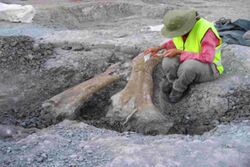Earth:Villalba de la Sierra Formation
| Villalba de la Sierra Formation Stratigraphic range: Campanian-Maastrichtian ~84–66 Ma | |
|---|---|
 Excavation of a titanosaur at Lo Hueco | |
| Type | Geological formation |
| Lithology | |
| Primary | Mudstone |
| Other | Sandstone, gypsum |
| Location | |
| Coordinates | [ ⚑ ] : 40°00′N 2°00′W / 40.0°N 2.0°W |
| Paleocoordinates | [ ⚑ ] 30°42′N 0°36′W / 30.7°N 0.6°W |
| Region | Castilla-La Mancha |
| Country | |
| Extent | Iberian Ranges |
| Type section | |
| Named for | Villalba de la Sierra |
The Villalba de la Sierra Formation is a Campanian to Maastrichtian geologic formation in Spain . Fossil dinosaur eggs have been reported from the formation, that comprises gypsiferous, grey, argillaceous mudstones and sandstones, deposited in a floodplain environment[1][2] characterised by high seasonality and variability in water availability.[3]
Fossil content
The formation has provided abundant titanosaurian remains, including Lohuecotitan were found in the formation.[4] More than 10,000 fossil remains of various fishes, amphibians, lizards, dinosaurs (Ampelosaurus sp., Rhabdodon sp.), turtles (Foxemys mechinorum, Iberoccitanemys convenarum), and crocodiles (Lohuecosuchus megadontos, Agaresuchus fontisensis, Musturzabalsuchus sp.) are also known from the site, one of the richest for the Late Cretaceous in Europe.[4][5]
See also
- List of dinosaur-bearing rock formations
- List of stratigraphic units with few dinosaur genera
- Dinosaur eggs
- List of stratigraphic units with few dinosaur genera
References
- ↑ Lo Hueco, Fuentes (G1) at Fossilworks.org
- ↑ Weishampel et al., 2004, pp.517-607
- ↑ Peyrot, Daniel; Barroso-Barcenilla, Fernando; Cambra-Moo, Oscar (1 October 2013). "Paleoecology of the late Campanian/early Maastrichtian Fossil-Lagerstätte of "Lo Hueco" (Cuenca, Spain): Palynological insights". Palaeogeography, Palaeoclimatology, Palaeoecology 387: 27–39. doi:10.1016/j.palaeo.2013.07.005. https://www.sciencedirect.com/science/article/abs/pii/S003101821300326X. Retrieved 22 November 2022.
- ↑ 4.0 4.1 Díez Díaz et al., 2016
- ↑ Ortega et al., 2015
Bibliography
- Díez Díaz, V.; P. Mocho; A. Páramo; F. Escaso; F. Marcos-Fernández; J.L. Sanz, and F. Ortega. 2016. A new titanosaur (Dinosauria, Sauropoda) from the Upper Cretaceous of Lo Hueco (Cuenca, Spain). Cretaceous Research 68. 49–60.
- Knoll, M.; D. Segura; F. Barroso-Barcenilla; P.M. Callapez; O. Cambra-Moo; V. Daviero- Gómez; V. Díez Díaz; L. Domingo, and A. Elvira. 2015. The biota of the Upper Cretaceous site of "Lo Hueco" (Cuenca, Spain). Journal of Iberian Geology 41. .. doi:10.5209/rev_JIGE.2015.v41.n1.48657
- Weishampel, David B.; Peter Dodson, and Halszka Osmólska (eds.). 2004. The Dinosauria, 2nd edition, 1–880. Berkeley: University of California Press. Accessed 2019-02-21. ISBN:0-520-24209-2
 |


